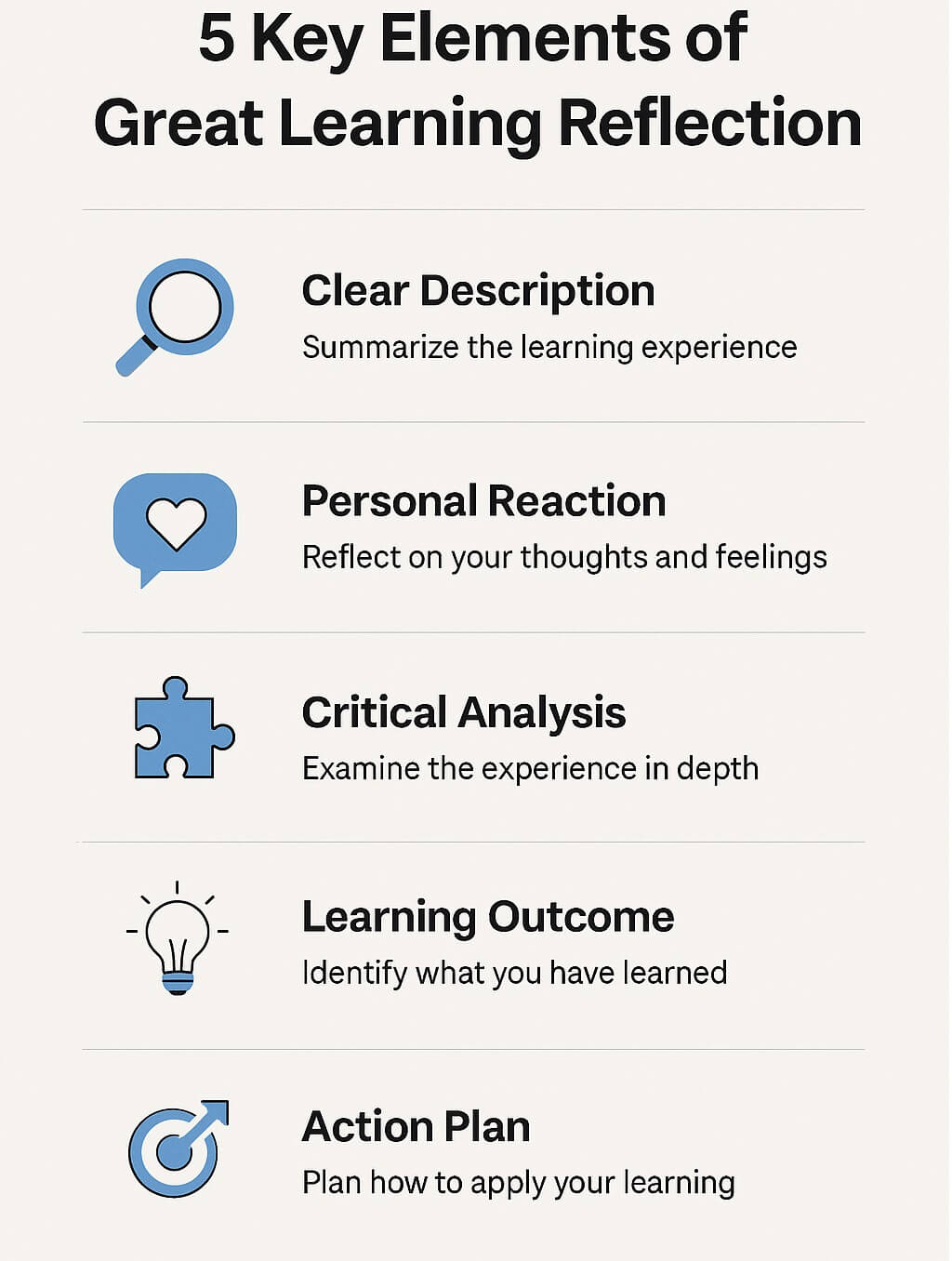
Understand the power of thoughtful reflection in transforming knowledge into lifelong learning.
Have you ever finished a course, project, or assignment and felt just done — but not necessarily wiser? That is where learning reflection comes in.
A great learning reflection does more than summarize what happened. It dissects, connects, and personalizes knowledge. It builds self-awareness and deepens understanding, transforming information into lasting growth.
But here's the challenge: most learners do not know how to reflect effectively. They either over-explain events or gloss over insights. So, how do you craft a meaningful, high-impact learning reflection?
This article explores the five essential elements of a great learning reflection, backed by educational psychology, real-life application, and practical frameworks. Whether you are a student, educator, or lifelong learner, this guide will change how you approach learning.
Table of Content
- 1. Clear Description of the Learning Experience
- 2. Personal Reaction and Emotional Insight
- 3. Critical Analysis and Connection to Theory
- 4. Identification of Learning Outcomes
- 5. Action Plan for Future Learning or Improvement
- Real-Life Example: From Confusion to Clarity
- The Science Behind Reflective Learning
- Mistakes to Avoid in Learning Reflection
- Tips for Educators: How to Encourage Better Reflection
- Top Digital Tools for Reflective Practice
- Key Takeaways
- Conclusion
- Frequently Asked Questions

1. Clear Description of the Learning Experience
What Happened? (Keep It Focused)
Before analyzing, you need to set the stage. A strong reflection begins with a concise overview of the learning experience, whether it was a lecture, project, discussion, or real-world challenge.
Include:
-
Context (course, project, or setting)
-
Your role or contribution
-
Key actions or turning points
-
Relevant highlights
Example:
"During our final group presentation for the Organizational Behavior course, I analyzed team dynamics and communication breakdowns."
This provides a solid foundation for deeper insight. Avoid listing every detail — focus on the moments that matter.
2. Personal Reaction and Emotional Insight
What Did You Feel, Think, or Experience?
Reflection is personal. It is about what happened and how you experienced it — emotionally, mentally, and socially.
Ask yourself:
-
Was I frustrated, curious, proud, or overwhelmed?
-
Why did I feel that way?
-
How did these feelings influence my behavior or learning?
Emotional insight adds depth. Sharing your thoughts and emotions brings authenticity and relatability. It helps track personal development and gives educators helpful context.
Example:
Initially, I felt overwhelmed by the ambiguity of the task. I realized I rely heavily on structure, which triggered anxiety, but it also pushed me to develop better self-direction.
This adds emotional intelligence to academic reflection.
3. Critical Analysis and Connection to Theory
So What? Connect Experience to Knowledge
This is the core of reflective learning — connecting personal experience with course content, theories, and skills.
Instead of just stating what happened, ask:
-
Why did this occur?
-
What does this reflect about a concept or theory?
-
How does this relate to real-world applications?
Make it analytical by linking your experience to:
-
Course readings or frameworks
-
Observed patterns or principles
-
Causal relationships or underlying mechanisms
Example:
"Our team’s miscommunication aligns with Tuckman’s 'storming' phase in group development. Recognizing this helped me view conflict as a normal part of team growth."
This shift from description to critical thinking strengthens learning outcomes.
4. Identification of Learning Outcomes
What Did You Learn? Be Specific
A strong reflection clearly states what was learned about the topic, the process, or oneself.
Ask:
-
What new knowledge or skills did I gain?
-
How has my thinking changed?
-
What patterns or insights emerged?
Avoid general statements. Be precise and practical.
Example:
"I learned that clear communication in teams involves not just speaking but reading non-verbal cues and emotional tone. I now pay closer attention to team dynamics."
This shows internalization of lessons and readiness to apply them.
5. Action Plan for Future Learning or Improvement
Now What? Turn Insight Into Strategy
Reflection must lead to action. Consider:
-
What will I do differently next time?
-
What habits or tools will I implement?
-
How can I measure my improvement?
Make it forward-looking. Set clear, achievable goals.
Example:
"In future group projects, I will initiate short check-ins at the start to clarify roles and expectations. This could reduce confusion and improve collaboration."
This helps translate learning into sustainable behavior change.
Real-Life Example: From Confusion to Clarity
Tara, a third-year business student, once submitted this basic reflection:
"I should manage time better. I missed some deadlines."
With guidance, she revised it using the five elements:
-
Experience: "I worked on a marketing project with tight deadlines and underestimated the research time."
-
Emotion: "I felt stressed watching others progress faster, which lowered my confidence."
-
Analysis: "This reflects the planning fallacy — a cognitive bias where we underestimate how long tasks take."
-
Learning Outcome: "I learned the value of realistic planning and setting buffers for unexpected tasks."
-
Action Plan: "I now use time-blocking and a prioritization matrix to manage my tasks."
This version was more insightful and led to real improvement in her academic performance.
The Science Behind Reflective Learning
Why It Works
Reflection activates metacognition — thinking about one’s thinking — which enhances:
-
Self-regulation
-
Knowledge retention
-
Transfer of learning across contexts
According to David Kolb’s Experiential Learning Cycle, learning becomes meaningful when learners reflect on their experiences, conceptualize insights, and apply them to new situations.
Reflection is where deeper learning takes place.
Mistakes to Avoid in Learning Reflection
-
Over-explaining what happened without analyzing it
-
Ignoring emotional responses
-
Skipping connections to theory or intended learning outcomes
-
Writing vague or generic takeaways
-
Failing to include specific actions for improvement
Tips for Educators: How to Encourage Better Reflection
-
Provide structured prompts that encourage analysis
-
Use rubrics that reward depth over length
-
Foster a safe, open environment for honest responses
-
Offer examples of effective reflections
-
Embed reflection into learning design and feedback processes
Top Digital Tools for Reflective Practice
Recommended Platforms:
-
Notion or Obsidian — for structured journaling and knowledge tracking
-
Padlet — for collaborative reflection sharing
-
Google Docs — for private or shared journaling with feedback
-
LMS templates — to scaffold reflective assignments
These tools can support ongoing reflection in both individual and group learning environments.
Key Takeaways
-
Reflection is not a summary — it is a personal and intellectual process that connects experience to growth
-
The five elements are: description, emotion, analysis, learning outcome, and action
-
Reflective writing fosters metacognition, emotional intelligence, and long-term improvement
-
Effective reflection is a skill that strengthens with practice and intention
-
Educators and learners alike benefit from building a culture of structured, meaningful reflection
Conclusion
Great learners do not just do — they reflect. They pause to ask:
-
What did I gain?
-
How did I grow?
-
What is next?
The five elements of effective reflection offer a blueprint for turning experience into insight. The next time you are asked to write a reflection, do not treat it as a task to finish. Treat it as an opportunity to develop, both personally and intellectually.
Reflection helps turn passive learning into active growth, education's real goal.
Frequently Asked Questions
1. How long should a learning reflection be?
Typically between 500 and 800 words. Focus on clarity and depth rather than word count.
2. Can I use the word "I" in a reflection?
Yes. A reflection is personal and should be written in the first person.
3. How is a reflection different from a summary?
A summary states what happened. A reflection explains why it mattered and what you learned.
4. How often should students reflect?
Regular reflection is recommended — weekly or after major tasks or learning milestones.
5. Are reflective skills valued professionally?
Yes. They demonstrate self-awareness, critical thinking, and adaptability — essential in the modern workplace.





